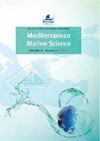地中海东北部七个海鞘(海鞘目)种
IF 2.3
3区 环境科学与生态学
Q1 MARINE & FRESHWATER BIOLOGY
引用次数: 0
摘要
被囊动物是海洋滤食性脊索动物的一个亚门,生活在从潮下到深海的所有海洋和海洋栖息地。被囊动物被认为是脊椎动物的近亲,被广泛用作进化、异体识别、衰老和全身再生研究的模式生物。然而,由于许多被囊动物类群具有高度的形态和遗传可塑性,物种边界知之甚少。在此,我们报告了来自地中海东北部土耳其6个地点的7种被囊动物(Botrylloides israeliense、Botrylloides sp.、Botryllus humilis、Botryllus schlosseri、Symplegma brakenhielmi、Polyclinum constellatum和Didemnum perlucidum)的研究结果,并利用线粒体barcoding标记(COI)评估了地理上受限制和广泛分布的海鞘物种之间的关系。除了从GenBank获得的序列外,还使用本研究生成的序列进行物种划分。在采样点记录了菌落的一般形态特征和颜色。然后,将所有柱头科菌落附着在水产养殖室的载玻片上进行培养,利用立体显微镜和光学显微镜研究其他特征,如动物分布和大小、口触须数量和生命周期。光镜下观察了经福尔马林固定的光露珠标本的针状结构。然后,根据物种划分结果和获得的COI序列与GenBank序列的比较,为所有物种分配学名。发现来自安塔利亚地区的Botrylloides新种(Botrylloides sp.),其COI基因与来自沙特阿拉伯的另一标本的COI基因匹配度达99%;进一步等待详细的传统分类法。本文章由计算机程序翻译,如有差异,请以英文原文为准。
Seven ascidian (Tunicata) species from the North Eastern Mediterranean
Members of the tunicates, a subphylum of marine filter-feeder chordates, inhabit all marine and oceanic habitats from the subtidal to the abyssal. Considered the closest relatives to the vertebrates, the tunicates are widely used as model organisms for evo-devo, allorecognition, senescence, and whole-body regeneration studies. However, species boundaries are poorly understood due to the high morphological and genetic plasticity that characterizes many tunicate taxa. Here, we present findings on seven tunicate species (Botrylloides israeliense, Botrylloides sp., Botryllus humilis, Botryllus schlosseri, Symplegma brakenhielmi, Polyclinum constellatum and Didemnum perlucidum) sampled from six Turkish sites at the North Eastern Mediterranean Sea and employed the mitochondrial barcoding marker (COI) for evaluating the relationships among geographically restricted and widely spread ascidian species. Species delimitation was conducted using sequences generated in the current study in addition to sequences obtained from GenBank. General morphological features and colors of colonies were recorded at sampling sites. Then, all Styelidae colonies were attached and cultured on slides in an aquaculture room, enabling the study of other features, such as zooid distributions and sizes, oral tentacle numbers, and life cycles, using stereo and light microscopes. The spicules of formalin-fixed Didemnum perlucidum samples were examined under a light microscope. Then, scientific names were assigned to all species based on the results of the species delimitation and on comparisons of the obtained COI sequences with GenBank sequences. A putative new Botrylloides species (Botrylloides sp.) from the Antalya region was revealed, with a 99% match with the COI gene of another specimen from Saudi Arabia; further waiting for detailed traditional taxonomy.
求助全文
通过发布文献求助,成功后即可免费获取论文全文。
去求助
来源期刊

Mediterranean Marine Science
MARINE & FRESHWATER BIOLOGY-
CiteScore
5.20
自引率
17.90%
发文量
34
审稿时长
>12 weeks
期刊介绍:
The journal Mediterranean Marine Science (MMS), published by the Hellenic Centre for Marine Research (HCMR), issues three volumes annually. The journal welcomes original research articles, short communications, New Mediterranean Biodiversity records, extended reviews, comments, and Theme sections in all fields of Oceanography, Marine Biology, Marine Conservation, Fisheries and Aquaculture in the Mediterranean area and the adjacent regions. All content is peer reviewed.
 求助内容:
求助内容: 应助结果提醒方式:
应助结果提醒方式:


